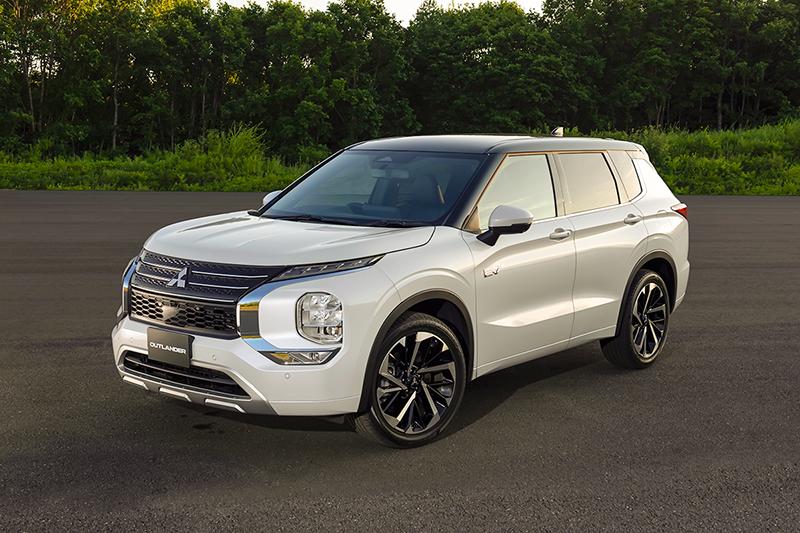Mitsubishi Outlander plugs into the trend
for more efficient motoring – second time around.
Mitsubishi’s MY 22 Outlanders have been flying out of dealership doors like leaves off the trees in Autumn.
January was a record month for the Triple Diamond’s hero SUV with 1188 units registered for a mind blowing 46.1 percent share of the market – a figure which is consistent with a new vehicle release.
With one month of ‘regular’ sales post the initial release date, the numbers are a little lower but still impressive with 524 units registered for 29.4 percent share, just a whisker under double that of its nearest competitor, which happens to be Toyota.
For March, we are likely to see the numbers surge again with the release of the new and improved plug-in hybrid electric model. After which, we are predicting a ‘settle down’ April assuming supply isn’t restricted, and Mitsubishi seems to be able to keep on top of this far better than most.
This will certainly bode well for Mitsubishi’s balance books and will likely cause something of a dent in Shell/Mobil/Gull/Z/Waitomo/BP profit centres – albeit a small one.
And so how all-new is the all-new Outlander PHEV?
Mitsubishi tells us the battery capacity has been increased by 45 percent which translates to a 52 percent increase in pure EV range, a greater liquid fuel capacity and a powerful new 185kW / 450Nm EV drive system.
According to our often-dodgy maths, the range of the PHEV should now be something on the order of 84km, bearing in mind the preceding model claimed a 55km pure EV range.
The liquid fuel capacity has seen an increase of 24 percent which means the combined driving range is up 50 percent over the previous model, which makes the Outlander PHEV even more attractive, even with the mercurial price of petrol.
And yes, there has been a revision of the electric motors, the one at the front and the one at the rear which means an upgrade in power and torque total outputs from 130kW to 185kW (cripes! The Lancer Evo was only 207kW!) and the torque is now 450Nm (that’s ute-type torque) up from 332Nm.
Outlander PHEV’s petrol engine has seen some improvement too, though not to the point of adopting the regular Outlander’s 2.5 litre upgrade.
The Outlander PHEV still runs the 2.4 litre 4B12 engine, but this has seen improvements to the manifold, the addition of a cooled exhaust gas recirculation system and upgraded spark plugs to improve fuel efficiency.
Since we are being technical, all PHEV models – five-seater LS and seven-seat XLS and VRX grades – have All-Wheel-Drive systems with Super All Wheel Control (S-AWC).
S-AWC amalgamates longitudinal (forward to back) torque distribution, lateral (side to side) torque vectoring through the active yaw control system and four-wheel brake control to give sure traction in all drive applications.
It is supplemented by an improved Drive Mode selector which features a new Power setting for the Outlander PHEV, in addition to the Eco, Normal, Tarmac, Gravel, Snow and Mud modes.
The Power mode increases acceleration and acceleration response, while at the same time, providing a more direct steering feel.
For greater – electric – interaction between driver and vehicle, the SDA (Smartphone Link Display Audio) system has seen some ‘PHEV-isation,’ with a dedicated screen to display energy usage, nearby charging stations, charging timer, climate control and EV settings.
There is more to the Outlander PHEV for 2022, but we don’t want to spoil all the surprises!
However, a word to the wise: Mitsubishi New Zealand announced it had 500 pre-orders already registered at time of writing, which suggests the new generation PHEV might well exceed our registration predictions for the next four months.
Mitsubishi’s predictions go a little beyond ours, the company expects the demand for the Outlander PHEV will outstrip the petrol equivalents within 12 months.
Pricing for the all-new PHEV has been released, though in typical Mitsubishi fashion, there is a special introductory pricing offer: the LS is available from $60,990 + ORC ($54,240 + ORC once the Clean Car Discount is applied).
Pricing is reported to be:
Outlander PHEV LS $69,990 + ORC,
Outlander PHEV XLS $75,990 + ORC,
Outlander PHEV VRX $79,990 + ORC.
Stop Press: Announced just in time to catch before printing. The new Mitsubishi Outlander PHEV has secured a five-star ANCAP safety rating.
This is not an unexpected development, as the ICE-powered Outlander also has a five-star rating. ANCAP did however, perform separate tests on the PHEV model to ensure it met the same stringent protocols for vehicle and pedestrian safety.
Mitsubishi’s Outlander PHEV range then, carries the same extensive safety features, including, but not limited to:
• Collision Mitigation system, with pedestrian detection
• Driver Attention Alert
• Lane Departure Warning
• Lane Departure Prevention
• Emergency Lane Assist
• Emergency Stop Signal function
• Emergency Brake Assist system
• Hill Descent Control
• Trailer Stability Assist
• Adaptive Cruise Control
• Anti-lock Braking System
• Electronic Brakeforce Distribution
• Brake Override System






